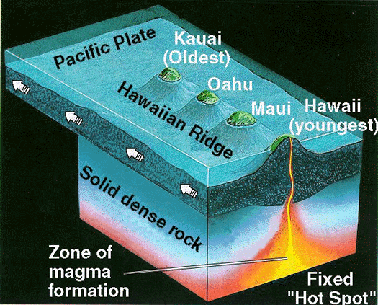
Hot Spot volcanoes are recognized by an age progression from one end of the chain to the other. An active volcano commonly serves as an "anchor" at one end of the chain. The most studied and best well-known hot spot volcanoes and seamounts define the Hawaii-Emperor volcanic chain. The origin and evolution of Hawiian volcanoes, seamounts, and guyots are described in the Hawaiian Volcano Lessons.
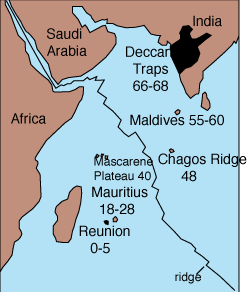
Left: Another noteworthy hot spot track extends from India to the island of Reunion. About 66-68 million years ago present-day India was above the hot spot and great volumes of basaltic lava erupted to produce the Deccan Traps. As the plate moved northeast over the hot spot more volcanic centers formed: the Maldives from 55-60 million years ago, the Chagos Ridge 48 million years ago, the Mascarene Plateau 40 million years ago, and the Mauritus Islands from 18-28 million years ago. The youngest volcanoes, Piton des Neiges and Piton de la Fournaise, formed in the last 5 million years. The summits of these volcanoes make the island of Reunion. Piton des Neiges is extinct. Piton de la Fournaise is one of the most active volcanoes on Earth. Map from Scarth (1994).
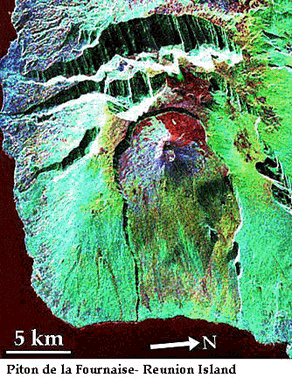
Right: Piton de la Fournaise is also one of the biggest volcanoes on Earth. From the ocean floor it is over 21,600 feet (6,600 m) tall. The base of the volcano has a diameter of 135 miles (220 km)(the base of Mount St. Helens has a diameter of about 9 km). Because of Piton de la Fournaise's great size it is unstable and collapses to form giant landslides like those in Hawaii. This SIR-C image shows the summit of the volcano and the scarps of the giant landslides. Image courtesy of Pete Mouginis-Mark, University of Hawaii.
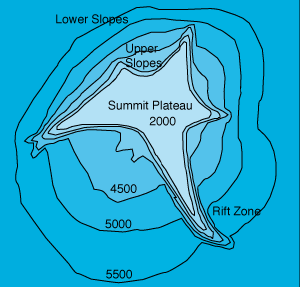
A volcano above a hot spot does not erupt forever.
Eventually the movement of the tectonic plate carries the volcano off of its magma supply. The volcano becomes extinct and cools. The plate beneath the volcano (and above the hot spot) also cools. The rocks that make the volcano and plate become more dense. The volcano and the plate gradually subside as they move away from the hot spot. Even giant volcanoes, like Mauna Loa on Hawaii, will eventually disappear into the ocean. As the volcano subsides below sea-level the top is eroded flat by waves. This series of steps leads to a series of evolutionary stages that are well illustrated by the Hawaii-Emperor volcanic chain. This series of steps explains the formation of most guyots, seamounts with flat tops. Other explanations proposed for the formation of guyots include extrusion of lava from ring-shaped conduits. This topographic map of a large guyot is from Vogt and Smoot (1984).
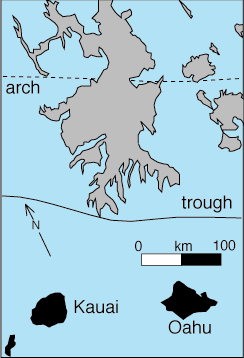
The North Arch volcanic field was recently discovered north of Oahu and is related to the Hawaiian hot spot. The volcanic field is on the Hawaiian Arch. The arch is about 600 feet (200 m) high and formed by the weight of the adjacent islands causing the crust to bend. The volcanic field is made of flood basalts that cover an area of 9,650 square miles (25,000 square km). The flows extend about 60 miles (100 km) north and south away from the arch. The youngest lava range in age from 750,000 to 900,000 years old. The oldest flows are about 2.7 million years old. The field is made of sheetflows and small hills of pillow lava and hyaloclastite Chemically, the lavas are similar to the rejuvenated stage of Hawaiian volcanoes The North Arch volcanic field began erupting when the Waianea and Koolau volcanoes of Oahu were large shields and continue to erupt until Haleakala volcano on Maui was formed. Map from Clague and others (1990).